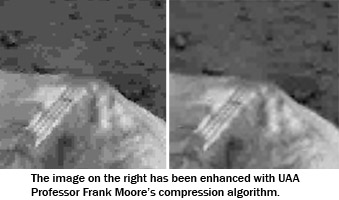When less is more: New image compression success could save millions
by Kathleen McCoy |

We all know the pain of sending a too-large photo via email, only to have it bounce
back into our can't-send file.
Or how about on the other end-the agony of pasting a too-small photo into a too-big web hole, and ending up with a fun-house pixelated version of the image. The photo was so compressed, too much of its visual information disappeared.
Now imagine you are NASA, trying to capture high-resolution images of the Martian landscape and then transmit them across millions of miles of space over limited bandwidth channels-losing as little information as possible while achieving as much compression as possible. Even with our narrow experience doing Earth-bound photo transmission, we can tell this is complex and really hard.
If you are Frank Moore, a computer science professor at UAA, this is your problem to solve, which you happen to be quite excited about.
That's because Moore has had recent success "squeezing" images through compression, but retaining high resolution, results that promise to go beyond the best NASA has ever seen.
Learn more about Moore's discovery and how its applications benefit us Earthlings.
 "When less is more: New image compression success could save millions " is licensed under a Creative Commons Attribution-NonCommercial 4.0 International License.
"When less is more: New image compression success could save millions " is licensed under a Creative Commons Attribution-NonCommercial 4.0 International License.









